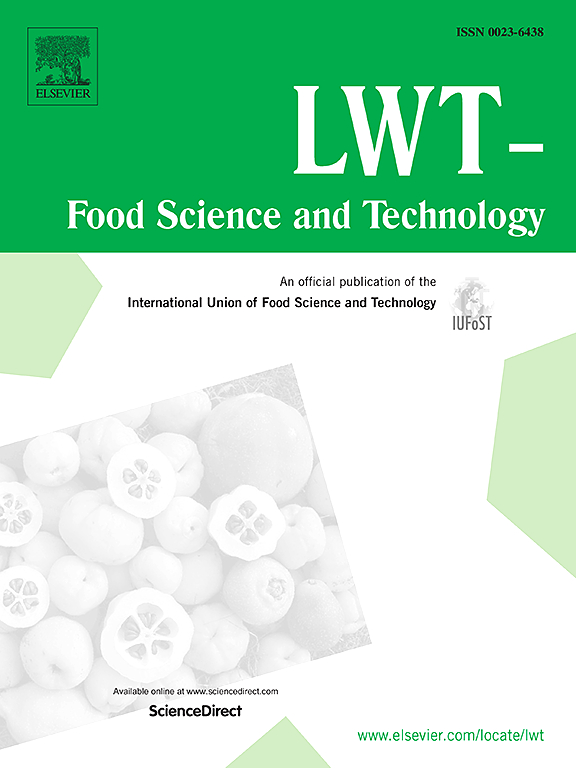The effect of cold plasma pretreatment on drying efficiency of beetroot by intermittent microwave-hot air (IMHA) hybrid dryer method: Assessing drying kinetic, physical properties, and microstructure of the product
IF 6
1区 农林科学
Q1 FOOD SCIENCE & TECHNOLOGY
引用次数: 0
Abstract
This study examined the effects of cold plasma (CP) pretreatment with durations of 1, 3, and 5 min on drying kinetics, microstructure, and physical properties, including shrinkage, rehydration ratio (RR), and bulk density of beetroot dried samples using intermittent microwave-hot air (IMHA) drying at 40 °C and pulse ratios (PR) of 1 and 2. While increasing PR decreased drying rate (DR) and effective moisture diffusivity (Deff), increasing microwave power from 180 to 600 W increased both, reducing drying time and specific energy consumption (SEC). Extended CP-pretreatment doubled DR, 66% increased Deff, and 24% reduced SEC. Both increasing CP-pretreatment time and microwave power had similar effects on shrinkage, RR, and bulk density, but CP-pretreatment was more prominent; reducing shrinkage by 18%, bulk density by 23%, and increasing RR by approximately 36% in 5-min. X-ray imaging showed that 600 W of microwave power increased porosity by 87%, while 5-min CP-pretreatment increased it by 27%. As the optimum condition, CP-pretreatment for 5 min, continuous microwave application, and 600 W of MW power produced the best kinetics and physical properties. Overall, the results demonstrated that the appropriate CP-pretreatment duration could produce high-quality dried samples.
冷等离子体预处理对间歇微波-热空气(IMHA)混合干燥器法干燥甜菜根效率的影响:评估产品的干燥动力学、物理性质和微观结构
本研究考察了冷等离子体(CP)预处理(持续时间为 1、3 和 5 分钟)对甜菜根干燥样品的干燥动力学、微观结构和物理性质(包括收缩率、复水率 (RR) 和体积密度)的影响,采用的是间歇式微波-热空气(IMHA)干燥,温度为 40 °C,脉冲比 (PR) 为 1 和 2。虽然提高脉冲比会降低干燥速率(DR)和有效水分扩散率(Deff),但将微波功率从 180 W 提高到 600 W 则会提高这两项指标,同时缩短干燥时间并降低特定能耗(SEC)。延长 CP 预处理时间可使 DR 增加一倍,Deff 增加 66%,SEC 减少 24%。增加 CP 预处理时间和微波功率对收缩率、容重和体积密度的影响相似,但 CP 预处理的效果更显著;5 分钟内收缩率降低了 18%,体积密度降低了 23%,容重提高了约 36%。X 射线成像显示,600 W 微波功率可使孔隙率增加 87%,而 5 分钟的 CP 预处理可使孔隙率增加 27%。作为最佳条件,5 分钟的 CP 预处理、连续使用微波和 600 瓦的微波功率产生了最佳的动力学和物理性能。总之,研究结果表明,适当的 CP 预处理时间可以生产出高质量的干燥样品。
本文章由计算机程序翻译,如有差异,请以英文原文为准。
求助全文
约1分钟内获得全文
求助全文
来源期刊

LWT - Food Science and Technology
工程技术-食品科技
CiteScore
11.80
自引率
6.70%
发文量
1724
审稿时长
65 days
期刊介绍:
LWT - Food Science and Technology is an international journal that publishes innovative papers in the fields of food chemistry, biochemistry, microbiology, technology and nutrition. The work described should be innovative either in the approach or in the methods used. The significance of the results either for the science community or for the food industry must also be specified. Contributions written in English are welcomed in the form of review articles, short reviews, research papers, and research notes. Papers featuring animal trials and cell cultures are outside the scope of the journal and will not be considered for publication.
 求助内容:
求助内容: 应助结果提醒方式:
应助结果提醒方式:


